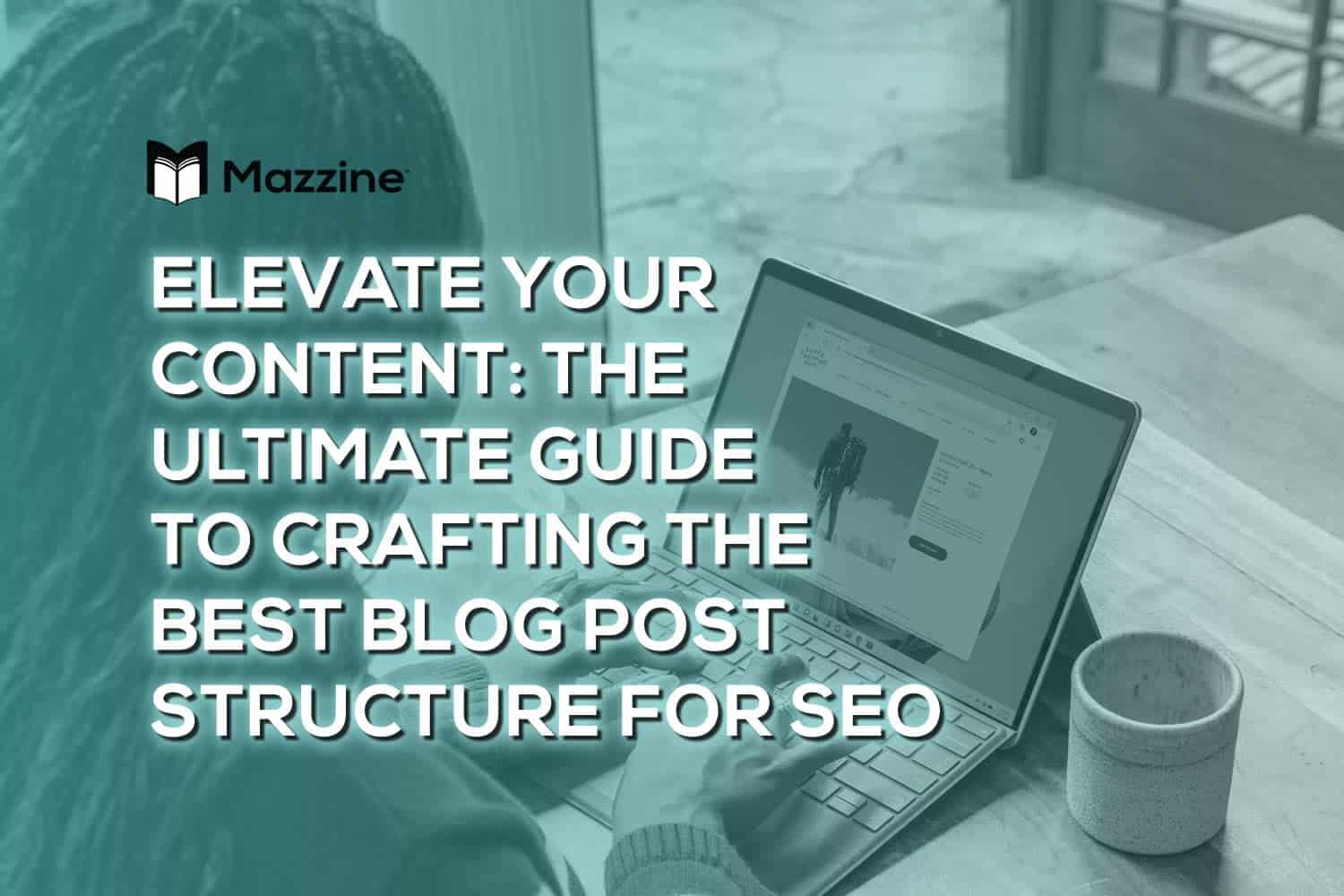In the ever-evolving landscape of digital content, mastering the intricacies of a blog post structure is the key to unlocking unparalleled success in search engine optimization (SEO). Beyond aesthetics, the way you structure your blog posts plays a pivotal role in how search engines perceive and rank your content.
This comprehensive guide aims to demystify the art of creating the Best Blog Post Structure, offering insights and strategies that go beyond the basics. From crafting compelling headlines to optimizing content organization, we’ll explore every facet that contributes to enhanced visibility, increased reader engagement, and ultimately, higher search engine rankings.
Embark on a journey with us as we delve into the core elements of SEO-friendly blog post structures, providing you with actionable tips and best practices to transform your content into a magnet for search engines and readers alike. Let’s navigate the path to SEO mastery together.
Table of Contents
Understanding the Key Elements for the Best Blog Post Structure

Headline Analysis
1. Importance of a Keyword-Rich Headline
Crafting a keyword-rich headline is the first step to making your content visible to both readers and search engines. When users search for “Best Blog Post Structure,” a well-crafted headline ensures your content stands out and aligns with their intent. Incorporate the key phrase naturally, making it clear that your content addresses their specific query.
Actionable Tip: Use tools like Google Keyword Planner to identify variations of “Best Blog Post Structure” and seamlessly integrate them into your headline for maximum relevance.
2. Crafting Compelling Headlines for SEO Impact
A compelling headline not only grabs attention but also influences click-through rates and search rankings. Employ power words, evoke curiosity, and maintain clarity to strike a balance between engaging your audience and meeting SEO requirements. Think about what would make users click on your content over others in the search results.
Actionable Tip: Test different headline variations using A/B testing tools to see which resonates best with your target audience while maintaining SEO effectiveness.
Introduction Structure
1. Engaging Introductions and Their Role in SEO
Engaging introductions are critical for reducing bounce rates and improving SEO. Hook your audience with a concise yet captivating introduction that clearly introduces the main topic—Best Blog Post Structure. Incorporate the key phrase naturally, signaling to search engines that your content is relevant to users seeking insights on optimizing their blog structure.
Actionable Tip: Use storytelling techniques to create a connection with readers from the beginning, encouraging them to stay on your page longer.
2. Hooking Readers from the Start
The first sentence sets the tone for reader engagement. Pose a thought-provoking question, share a surprising statistic, or present a compelling anecdote related to blog post structures. This not only captivates your audience but also signals to search engines that your content is valuable and worth promoting.
Actionable Tip: Conduct user surveys or polls to understand what aspects of blog post structure your audience finds most challenging or interesting, and tailor your hooks accordingly.
Heading Hierarchy
1. Proper Use of H1, H2, and H3 Tags for SEO
Heading tags are not just formatting tools; they serve as signposts for both readers and search engines. Properly structure your content with H1, H2, and H3 tags, ensuring a logical hierarchy that reflects the importance of each section. This enhances both user experience and SEO by making your content more scannable and understandable.
Actionable Tip: Conduct a thorough content audit to ensure your existing content adheres to proper heading hierarchy, and update as needed for improved SEO.
2. Creating a Logical Flow Through Headings
Guide readers through your content seamlessly by creating a logical flow using headings. Each heading should provide a clear transition, aiding both user comprehension and search engine crawlers in understanding the structure of your content. This helps in retaining readers and improving the overall user experience.
Actionable Tip: Utilize descriptive subheadings that accurately represent the content beneath, making it easy for readers to navigate and find the information they seek.
Implementing these strategies not only enhances your content’s appeal to readers but also positions it favourably in search engine results for the targeted keyword “Best Blog Post Structure.”Content Organization Strategies
Importance of Paragraph Structure
1. Formatting for Readability and SEO
The art of crafting a well-structured paragraph extends beyond aesthetics; it significantly impacts both reader comprehension and SEO. Ensure your paragraphs are concise and focused, incorporating the key phrase “Best Blog Post Structure” where relevant. Paragraphs that are properly formatted not only enhance readability but also contribute to a positive user experience and improved search engine rankings.
Actionable Tip: Break down complex ideas into smaller, digestible paragraphs, making it easier for readers to follow along and for search engines to identify the key themes of your content.
2. Length Considerations for Paragraphs
Strike a balance in paragraph length to maintain reader engagement and align with SEO best practices. Avoid lengthy blocks of text that can overwhelm readers. Instead, focus on providing valuable information in a format that is easy to consume. Aim for a mix of short and medium-length paragraphs for optimal readability.
Actionable Tip: Use reader feedback and analytics to assess the ideal paragraph length for your specific audience, adapting your approach as needed.
Utilizing Bullet Points and Lists
1. Enhancing Content Scannability
In a world where attention spans are short, enhancing content scannability is crucial. Utilize bullet points and lists strategically to present information in a concise and organized manner. This not only caters to readers who prefer scanning but also signals to search engines that your content is well-structured and user-friendly.
Actionable Tip: Prioritize key information in lists, ensuring that readers can quickly identify and absorb the most important points.
2. SEO Benefits of Well-Organized Lists
Beyond improved readability, organized lists offer notable SEO benefits. Search engines appreciate well-structured content, and incorporating lists helps convey information efficiently. By presenting content in a clear, list format, you enhance the overall SEO performance of your content.
Actionable Tip: Include relevant keywords in your lists, making them not only user-friendly but also optimized for search engines.
Optimizing your content organization with these strategies ensures that your “Best Blog Post Structure” is not just a theoretical concept but a practical approach that enhances both reader experience and search engine visibility.
Visual Elements for SEO Enhancement
Incorporating Images
1. SEO-Friendly Image Optimization
Images are powerful tools for engagement, but they also play a crucial role in SEO. Optimize images by incorporating descriptive filenames and alt text, including variations of the key phrase “Best Blog Post Structure.” This not only enhances accessibility but also provides search engines with valuable context about your content.
Actionable Tip: Compress images to improve page loading speed, a factor that contributes to both user satisfaction and SEO rankings.
2. The Impact of Visuals on User Engagement and Bounce Rates
Engaging visuals are not just aesthetically pleasing; they contribute to lower bounce rates and increased user engagement. Strategically placed and relevant images capture the reader’s attention, encouraging them to stay longer on your page—an indicator of quality content that search engines value.
Actionable Tip: Conduct A/B testing with different image placements to determine the most effective positions for retaining user attention.
Infographics and Multimedia
1. SEO Advantages of Multimedia Content
Beyond traditional images, multimedia elements like infographics offer unique SEO advantages. Infographics provide a visually appealing way to convey information, making your content more shareable. Search engines recognize and reward content that is shared, contributing to improved visibility.
Actionable Tip: Create shareable infographic content that encapsulates key information related to the best blog post structure, encouraging readers to share and amplify your content.
2. Creating Shareable and Link-Worthy Visual Assets
The shareability of visual assets extends beyond infographics. Compelling visuals, including charts, graphs, and videos, can attract backlinks—valuable endorsements that contribute to higher search engine rankings. Focus on creating content that other websites in your niche find valuable and relevant.
Actionable Tip: Outreach to relevant websites in your industry to share your visual assets, increasing the likelihood of backlinks.
Mobile-Friendly Considerations
Responsive Design Importance
1. Google’s Emphasis on Mobile-Friendliness
With a significant portion of internet users accessing content on mobile devices, Google places a strong emphasis on mobile-friendliness. Ensure your blog post structure is responsive, providing a seamless experience across various screen sizes. Google rewards mobile-friendly websites with higher search rankings, reflecting the importance of catering to the mobile audience.
Actionable Tip: Use Google’s Mobile-Friendly Test to assess and improve your blog post’s responsiveness.
2. How to Ensure a Responsive Blog Layout
Achieving a responsive design involves optimizing elements such as font size, button sizes, and spacing to accommodate different devices. Prioritize a clean and intuitive layout that adapts to the user’s screen size, enhancing both usability and search engine visibility.
Actionable Tip: Regularly test your blog’s responsiveness and make adjustments based on user feedback and technological advancements.
Internal and External Linking Strategies
Building SEO Authority through Links
1. The Role of Internal Links in SEO
Internal links are not merely navigational aids; they contribute significantly to your blog’s SEO authority. Strategically interlink relevant content within your blog to guide readers to related topics. This internal linking structure enhances user experience and helps search engines understand the context and hierarchy of your content.
Actionable Tip: Conduct a content audit to identify opportunities for internal linking, ensuring that each link adds value to the reader.
2. Choosing Quality External Links
External links to authoritative and relevant sources contribute to your content’s credibility. When citing external sources, focus on quality over quantity. Search engines recognize outbound links to reputable websites, reinforcing the trustworthiness and authority of your content.
Actionable Tip: Establish relationships with influencers and experts in your industry, potentially leading to valuable backlinks and increased visibility.
Conclusion
1. Recap of Key Points
In this comprehensive guide, we’ve journeyed through the essential elements of crafting the Best Blog Post Structure for SEO. From strategic headlines to mobile-friendly design, each section has unveiled actionable tips to enhance your content’s visibility and engagement.
2. Encouraging Readers to Implement the Best Blog Post Structure for SEO
As you embark on implementing these strategies, remember that mastering blog post structure is an ongoing process. Continuously analyze your content, adapt to evolving SEO trends, and seek feedback from your audience. By consistently refining your approach, you’ll not only optimize for search engines but also provide an enriching experience for your readers.
Additional Resources
1. Recommended Tools for SEO-Friendly Content Creation
- Google Keyword Planner: Identify relevant keywords for your content.
- Google’s Mobile-Friendly Test: Ensure your blog post is optimized for mobile devices.
- A/B Testing Tools: Experiment with different headline variations and layouts.
2. Further Reading and References for In-Depth Understanding
- Moz’s Beginner’s Guide to SEO: A comprehensive resource for understanding the fundamentals of SEO.
- Neil Patel’s Content Marketing Hub: Insights into effective content marketing strategies.
Implementing the Best Blog Post Structure is not just a strategy; it’s a commitment to delivering valuable content to your audience. We hope this guide serves as a roadmap for your journey toward SEO excellence.
If you have any questions, feedback, or if there are specific topics you’d like us to explore in future guides, feel free to reach out. Happy crafting!
Further Reading:
- How to Write Better Blog Posts That Rank Well
- Blogging Made Easy: Pro Tips and Tricks to follow for a Winning Strategy
- 7 Blogging Mistakes That Are Hurting Your Success (And How to Fix Them)
- 10 Best Blogging Tools to Help You Write & Promote Your Content
- 12 Proven Tips to Get Your Blog Noticed Today
Write For Mazzine™
We hope our blog for bloggers about blogging has been helpful and provided value to you.
Interested in writing for Mazzine? We would love to hear from you! – Join our community of writers from around the world. – Check out the guidelines on the Write for us page.
FAQ
Why is the headline of a blog post so important for SEO, and how can I craft a keyword-rich headline?
The headline is crucial for SEO as it serves as a key signal to search engines about the content’s relevance. Crafting a keyword-rich headline involves seamlessly incorporating the target phrase, such as “Best Blog Post Structure,” ensuring it accurately represents the content. Use tools like Google Keyword Planner to identify variations and experiment with different options for optimal results.
How can engaging introductions impact both reader engagement and SEO performance?
Engaging introductions play a dual role. They captivate readers, reducing bounce rates and increasing dwell times, which positively impact SEO. Incorporating the key phrase naturally in your introduction aligns your content with search engine algorithms. Techniques like storytelling and posing questions can create an immediate connection with readers.
Why is a logical heading hierarchy important, and how can I effectively use H1, H2, and H3 tags for SEO?
A logical heading hierarchy enhances both readability and SEO. Proper use of H1, H2, and H3 tags helps search engines understand the structure and context of your content. Use H1 for main headings, H2 for subsections, and H3 for subheadings. This hierarchy creates a clear roadmap for readers and search engines, contributing to improved rankings.
How do images contribute to SEO, and what are some tips for optimizing them?
Images enhance both engagement and SEO. Optimize images by using descriptive filenames and alt text that include variations of the key phrase. Compress images to improve page loading speed, a factor considered by search engines. The strategic use of visuals not only makes your content more appealing but also provides valuable context for search engines.
Why is mobile-friendliness crucial for SEO, and how can I ensure a responsive blog layout?
Google prioritizes mobile-friendly websites due to the increasing number of users on mobile devices. Ensure a responsive design by optimizing font size, button sizes, and spacing to accommodate different screens. Regularly test your blog’s responsiveness and make adjustments based on user feedback and technological advancements to maintain a positive user experience and SEO performance.


